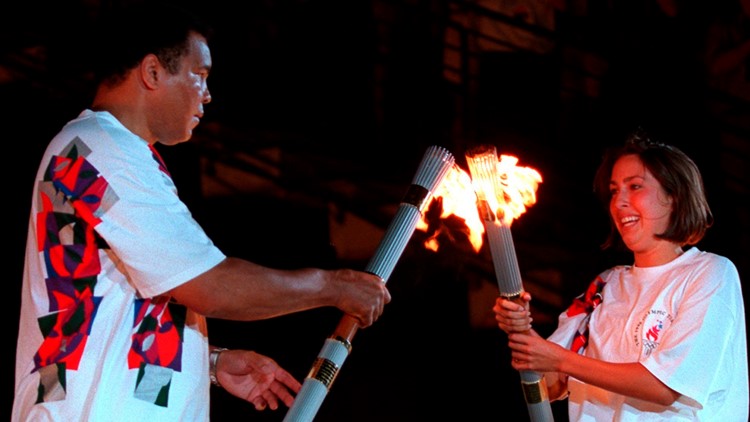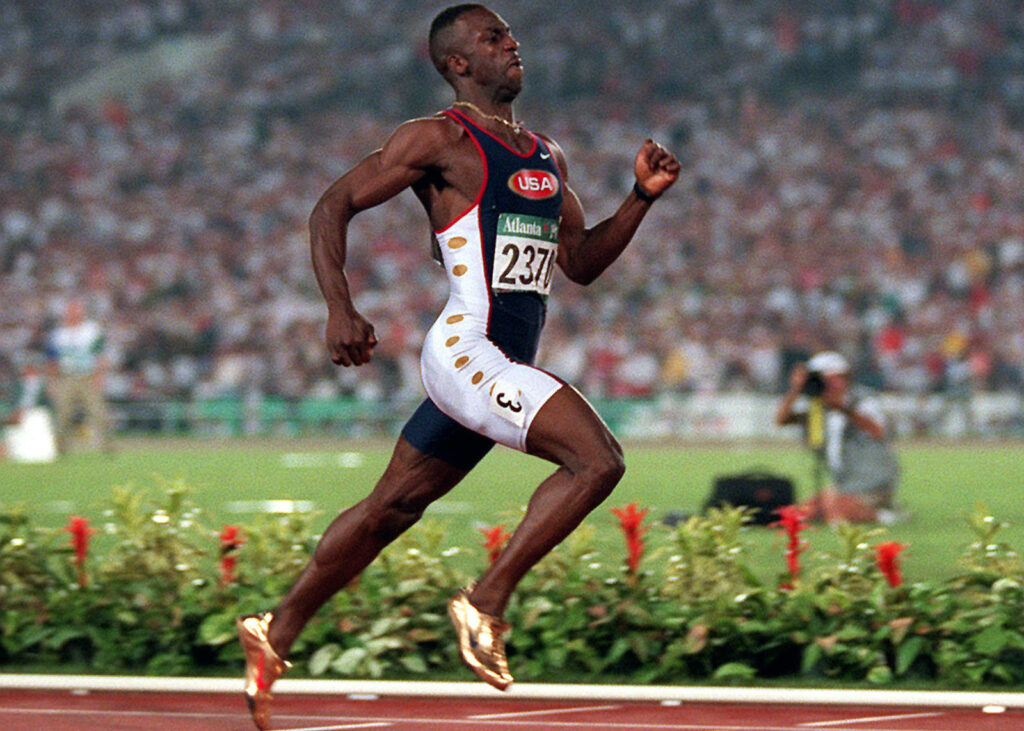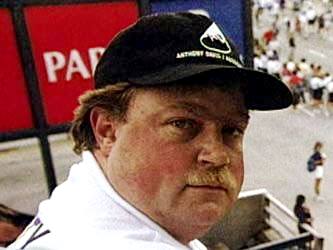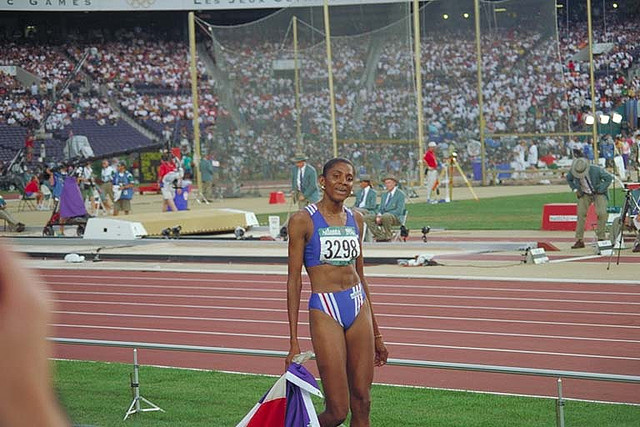There are, perhaps, three indelible images and one infamous but nevertheless unforgettable event associated with the 1996 Atlanta Olympics. Let’s take a look.
The images.
The opening and closing ceremonies have come a long way since they made their first appearances in 1908 and 1912 respectively and, from time to time, they provide moments that linger log after the Games themselves. Such was the case in Atlanta’s opening ceremony when Janet Evans – one of America’s greatest Olympic champion swimmers – made the last pass of the torch to another American Olympic hero who would light the cauldron where the flame would burn for the duration of the Games. That champion was, of course, Muhammad Ali.
[AP-Photo-Michael-Probst – fromWHAS11.]
In an interview celebrating the 20th anniversary of the Games, Evans recalled, “There was this moment, as the flame was being passed, I will never forget the look in his eyes. You could feel it. It was so meaningful to him. You could just see it in his eyes. It didn’t take any words. It was – outside of my family, of course – the greatest moment of my life.” And it was certainly a moment many of us will long remember.
The Magnificent Seven moment.
On their way to winning the first team gold medal in the history of U S A gymnastics, the seven women who traveled to Atlanta picked up the sobriquet The Magnificent Seven. The 1996 Olympics were the first and only time that the competing teams fielded seven members with each team able to select its six best performers to compete on each apparatus. All of the qualifying teams competed in the compulsory round with only the top four of (in order) Russia, United States, Romania, and Ukraine advancing to the optional round where they would compete for a medal.
The best known and most decorated American entering the competition was Shannon Miller whose notoriety was followed closely by the two Dominiques – Dawes and Moceanu. Amanda Borde, Amy Chow, Jaycie Phelps, and Kerri Strug rounded out the squad. Most of you probably recall what happened on the night of 23 July that ultimately produced the second iconic image. But to be certain, I’ll let Strug and Coach Béla Károlyi describe it.
(Although the coaches and competitors didn’t know it at the time, the American team had already secured the gold medal and Strug’s vault, athletically heroic as it was, was also unnecessary.)
Midas touched his feet.
The athletics competition began on 26 July and ran (threw and jumped) until 3 August with 44 events in the nine day period. The United States fared exceptionally well winning 13 gold medals (nearly 30 percent) and 23 overall. (Russia was second with 10 medals three of which were gold. Germany and France also won three gold medals.)
I’m certain my Canadian friends recall feeling a sense of redemption from the 1988 Ben Johnson scandal when Donovan Bailey established a new world record of 9.84 seconds in claiming the gold medal in the 100 meter dash but although he was also clocked at a top speed of 12.10 m/s (43.6 km/h or 27.1 mph), – the fastest top speed ever recorded by a human being at that time – Bailey didn’t provide the third and final iconic image.
On 29 July, American sprinter Michael Johnson won the gold medal in the 400 meter race with his time of 43.49 seconds setting a new Olympic record. Four days later, Johnson stepped on the track for the final in the 200 meter race. Johnson not only won the gold medal, he shattered the world record by three-tenths of a second with a winning time of 19.32 seconds. It remains the largest single improvement of a record at that distance. His apparel choice made the moment all the more memorable.
[From AP news.nike.com.]
After the race, the man with the gold shoes said, “I didn’t want to be standing there in gold-plated shoes with a silver medal around my neck.”
The wrong person of interest.
And then there was the event.
Sometime early on the morning of 27 July, a temporary security guard hired for the Olympics spotted a suspicious package under a bench in Centennial Olympic Park near an NBC sound tower. The 21 acre park was built as an adjunct to the games to serve as a sort of central meeting space and wasn’t subject to the same level of security as the official sites.
The guard, Richard Jewell, alerted the Georgia Bureau of Investigation who dispatched a bomb squad to investigate. Jewell and others began to evacuate the area but the bomb exploded only minutes after they had begun. Shrapnel from the blast immediately killed one person and injured 111 others. A cameraman working for the Turkish Radio and Television Corporation died of a heart attack while running to the scene.
Initially hailed as a hero, leaks from either the GBI, the FBI, or possibly both to an eager press soon pointed to Jewell as “a person of interest.”
[Photo from Wikipedia By-www.karendean.net.]
Aggressive and unquestioning reporting pointed an unwanted spotlight at Jewell who lived for several months as the subject of intense media interest and surveillance that included an effective media siege of his home. More months later, Jewell would be exonerated but never received even a mere apology from the news organizations that had besieged him. (Jewell did file a number of defamation suits against NBC News, The Atlanta Journal-Constitution, and others but after 15 years of litigation and nearly five years after Jewell’s death at age 44, the Georgia Court of Appeals ruled that the newspapers had accurately reported that Jewell was the key suspect in the bombing and wasn’t even entitled to an apology let alone any sort of compensation.)
Eventually, attention turned to Eric Robert Rudolph. After an extensive manhunt, Rudolph was arrested in 2003, pled guilty in 2005 not only to the Centennial Park bombing but to three others in the southeast. Rudolph was sentenced to life without parole and is serving his time in one of the highest security federal prisons in the U S.
Other news and notes.
The 1996 games were notable for three significant firsts. They were the first Olympic Games produced with no governmental support. Coca-Cola picked up $300,000,000 of the $1,700,000,000 tab.
They were also the first Olympic Games to which every invited National Olympic Committee (197) sent at least one athlete as well as being the first in which more than 10,000 athletes competed.
Athletes from a record-breaking 79 countries won medals and 53 countries won gold medals.
Cycling and football professionals were admitted to the competition.
For the first time there were no demonstration sports but beach volleyball, mountain biking, lightweight rowing and women’s football made their first appearance and softball made its debut as a sport for women only.
Frenchwoman Marie-José Pérec duplicated Michael Johnson’s feat (sans gold shoes) of winning gold medals in both the 200 meter and 400 meter races.
[Photo from Wikimedia Commons By sd_ukrm-CC-BY-SA-2.0.]
Turkish weightlifter Naim Suleymanoglu became the first weightlifter in history to win three consecutive Olympic titles.
Carl Lewis won the gold medal in the long jump. It was the ninth Olympic gold medal of his career and fourth in that event. He joined Al Oerter as the only person to win the same track and field event four times.
The freestyle wrestling tournament had a unique moment in the second round of the 82 kg (middleweight) weight class. Elmadi Zhabrailov representing Kazakhstan faced off against his older brother Lukman who was representing Moldova. The two were brothers from Chechnya. They elected not to represent Russia because of its invasion of their homeland. Elmadi won the match 10 points to 8 but finished sixth failing to duplicate his 1992 silver medal.



